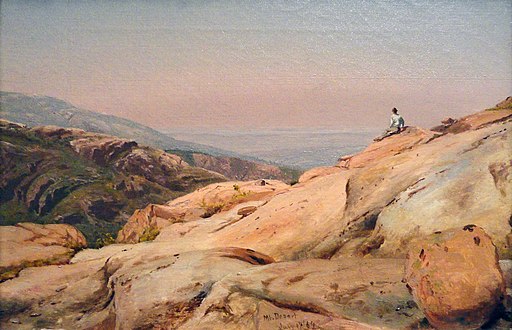 |
References for a finished painting
12x9 oil field study, plus photographs |
Some of today's plein air painters have the idea that starting and then finishing a painting in the field is the only way to portray the truth of the landscape. Plein air painting as the culmination of landscape art is, however, a fairly recent concept being bandied about today by plein air purists and organizers of plein air events. It's my opinion and also that of many landscape painters that the truth can be fully realized most successfully in the studio.
The idea of completing a painting in the field came about relatively recently, starting with the French Realists and then the Impressionists. Until then, if you wanted to paint a landscape, which was most likely the setting for a history painting or an illustration of classical myth, you went to the field with sketchbook and pencil to draw and add notes about color effects. If you didn't mind a little more baggage, you might take watercolors and capture those notes in color rather than pencil. You probably avoided taking oil colors, since that would require you to prep several pigs' bladders with the colors you required. The invention of the collapsible paint tube in 1841, however, made it easier to take out oils. But even so, the point of the outdoor excursion was to gather reference material that you could then build on in the studio. The early Hudson River School painters are noted for extensive field studies and the majestic paintings they created out of them.
Then the French Realists and the Impressionists came on the scene. Courbet, Monet and those who followed in their footsteps completed works entirely outdoors from life. For the Realists, it was a way to connect in a more raw and, therefore honest, way with the rural world. They wanted to stay true to the source. For the Impressionists, it was a way to connect with the "moment." Without observing and then immediately recording the impression, the precious qualities of that moment would be lost to memory by the time one got back to the studio. Suddenly, everybody was out painting and enjoying the sunshine.
But it wasn't long before the invention of photography and, especially, of color photography and the snapshot, made it possible for the painter to spend very little time in the field. (Albert Bierstadt, who came from the Hudson River School tradition, is notable as being one of the first landscape painters to make extensive use of photography, although he used it more as a supplement to his field sketches.) A click of the shutter was all it took to gather reference material. Despite the problems of working from photographs, many painters who had cut their teeth on field studies began working exclusively from prints and slides. Hobbyists and amateurs, who decided it was too much work dealing with wind, changing shadows and gnats, joined them. Still, work-from-life diehards continued to paint finished works outdoors, but quietly.
But then suddenly with new Millenium, retiring Baby Boomers, attracted by workshops offered in beautiful locations, picked up the brush and headed outdoors. A fad was born. Plein air painting competitions sprang up and even a magazine was dedicated to it. Gallery owners, art center directors and Chambers of Commerce realized that this was a marketing opportunity. Soon, every small, scenically-located town seemed to be hosting a plein air festival. This type of painting even evolved into an extreme sport, with painters hanging by their toes from cliffs or enduring snow storms and sub-zero temperatures. (Today, even the man-on-the-street knows what a "plain air" painter is, though he may not be able to spell it.)
At the competitions, the hot topic was, Does a work have to be painted exclusively outdoors to be considered plein air? If you spent a half-hour in the studio making adjustments, did that invalidate the work? Jokes about counting brush strokes and the like became common among some of the artists. Purists, however, didn't see it as a joke and argued against touching up or finishing a painting indoors.
It wasn't long before some of the painters, especially the professionals, began to tire of the plein air milieu. I'll never forget what one well-known painter whose plein air workshop I took several years ago said: "I'm getting tired of this whole plein air 'thing'." Artists began to yearn for the studio, a place where they had complete control over the weather, and where coffee could be brewed. Workshops began to have names like "From Study to Studio," and even the students began to look for a class where they could stay out of the wind.
And this is where we are today. Many artists who have always worked outdoors are now remembering the value of the studio. Besides coffee and controlled weather, the studio gives you the space and time to go further with design, color choices and mark-making. In the studio, you can enlarge your canvas, widen your scope and deepen your thinking. The result can be a more satisfying and rewarding effort than a two-hour sketch made on-location.
Don't let all this make you think I'm no longer a dedicated plein air painter. In fact, I'm more dedicated than ever. I am working even harder in the field, knowing that the information I get there will make or break what I do in the studio. In my plein air workshops (in
Sedona, Arizona, at www.PaintSedona.com and on
Campobello Island, New Brunswick, at www.PaintCampobello.com), I will show you how to maximize your efforts outdoors, no matter what your final destination.











.jpg)













